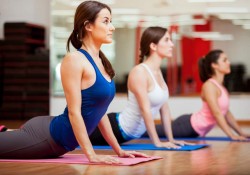
Yoga for bone health
05-04-2016 | Posted By: Admin | 1980 View(s)
Unlike other forms of exercise, this discipline helps with greater flexibility without damaging cartilage or stressing joints
Bone disorders are growing, and are beginning to strike younger people. The likely cause: stressed, skewed lifestyles.
We reach our maximum bone mass at around age 30. After that, it’s a matter of maintaining what we have. Today, however, bones are losing mass at a much faster rate than earlier. “Almost 75% of patients attending my clinic are under 40,” says Kedar Deogaonkar, consultant spine surgeon at the PD Hinduja Hospital and Medical Research Centre in Mumbai. Pradeep Sharma, Director and Head of the BLK Centre for Orthopaedics, Joint Reconstruction and Spine Surgery at the BLK Super Speciality Hospital in New Delhi, agrees.
On average, 15-20 patients who visit his out-patient department daily with complaints of metabolic bone disorders and other bone-related problems are youngsters, he says. Most of these people come with complaints like neck pain, lower back pain, general weakness—all symptoms of a weakening bone system, says Dr Sharma. “The threshold age limit of osteoporosis, which used to be 50-60 years, has come down to the late 30s, owing to drastic changes in lifestyle: late-night working, alcohol consumption, smoking and unhealthy food habits,” he adds.
Stress, too, is leading to musculoskeletal disorders, says Dr Deogaonkar. “The mental stress associated with the modern urban life contributes to poor eating habits and addictions,” he explains. “Unfortunately, most people have accepted the presence of stress in their lives as a by-default condition, and very little is being done to do away with it. It is piling up and degrading our general wellness,” adds Dr Sharma.
It’s time, then, to pay attention to your lifestyle. For, once you lose bone mass, it is difficult to get it back, so preservation of its strength and density is key. That’s where yoga can come in handy.
Yoga to the rescue
The general benefits of yoga are well known: greater flexibility, stronger muscles, better posture, reduced emotional and physical stress and increased self-esteem. You can add better bone health to the list.
Loren Fishman, a physiatrist at the US’ Columbia University who specialises in rehabilitative medicine, has been studying the effect of yoga on bone health for years, and a small pilot study that he began in 2005 came up with some encouraging results. Of the 117 patients in his study, 87 had osteoporosis, and 30 had osteopenia. Only 11 patients completed the two-year protocol of doing yoga every day for 10 minutes. In 2009, Dr Fishman reported that these 11 patients showed increased bone density in their spine and hips. The study concluded that practising yoga for just 8-10 minutes every day would raise bone quality.
Dr Fishman conducted another study over ten years, till 2015, with 741 elderly volunteers. His findings, published in November in the journal Topics In Geriatric Rehabilitation, showed improved bone density in the spine and femur among the 227 participants who practised 12 yoga poses every day. “This study proves that yoga is safe, even for people who have suffered significant bone loss,” Dr Fishman wrote in the study.
How it helps
Yoga is a weight-bearing exercise, which simply means you hold the weight of your body up against gravity. This puts mild stress on the bones and keeps them strong. “Yoga is a holistic approach towards the body and mind, which helps to discipline a person’s physical and mental attributes. It relieves stress, improves balance and thereby reduces the likelihood of falls,” says Dr Sharma.
Sandeep Agarwala, head of yoga at Ananda In The Himalayas, a spa resort in Uttarakhand, adds that unlike other weight-bearing activities, yoga doesn’t damage cartilage or stress the joints. Instead, it helps to strengthen and maintain bone health.
“There are a series of anti-arthritis asanas for loosening every joint of the body,” says Agarwala. The Tadasana, Tiryak Tadasana and Kati Chakrasana pose involve three different movements, like upward stretching, lateral stretching and twisting of the spine. Also, Trikonasana helps in developing body structure strength. Backwards-bending asanas, such as Bhujangasana, Sarpasana and Dhanurasana, are excellent for relieving back pain and strengthening the spine. Surya Namaskar, which has 12 positions, is a complete practice for bone strengthening. Combine these with pranayama and the relaxation techniques of Yoga Nidra, or yogic sleep, and you will get even better results.
Yoga can be done by almost everyone, as it is low- impact and easy on the body; you may need to exercise some caution if you suffer from back pain, a medical condition like diabetic retinopathy or are pregnant (some asanas may not be allowed in this case). “Consult your doctor before taking to yoga. Also, don’t use yoga to replace conventional medical care,” says Dr Sharma.
Stretching for Strength
Here are a few asanas that are good for the bones
Tadasana (Palm Tree Pose):
Stand with feet 10cm apart. Raise hands over the head, interlock the fingers and look straight. As you inhale slowly, stretch the arms upwards. Keep stretching till you are on your toes. Exhale as you lower your hands and bring your toes back to the floor. Repeat ten times.
Tiryak Tadasana (Side Palm Tree): Stand with legs 1eft apart. As you would be in Tadasana, interlock your fingers over the head, facing upwards, while keeping the arms straight. Exhale and bend sideways to the right. Then come back to the centre as you inhale. Exhale again and bend to the left. Repeat 7-10 times on each side.
Kati Chakrasana (Waist Rotation): Stand with legs 2ft apart, arms stretched to the sides at shoulder level. Exhale while twisting to the right. Place the left hand on the right shoulder and wrap the right arm around your back. Hold for a few seconds, and twist to the centre position. Repeat on the left side. Do 7-10 rounds on each side.
Trikonasana (Triangle Pose): Stand with legs 2ft apart. Turn the right foot to the right side and stretch the arms sideways at shoulder level. Bending sideways, bend the right knee and bring your right hand to touch the right foot, while raising the left arm up in line with the right arm. Look up towards your left palm pointing to the sky. Hold for a few seconds. Stand up slowly. Repeat on the left side. Do three-five rounds on each side.
Bhujangasana (Cobra Pose): Lie on your stomach, with your forehead on the floor and feet together. Place your hands underneath your shoulders, palms pressed flat on the floor. Raise your head, neck and shoulders off the floor as you slowly inhale, arching the back. Try to look upwards, and stretch as much as you can. You may bend your elbows slightly. Exhale as you lower yourself. Repeat five-seven times.
Credit : www.liivemint.com











